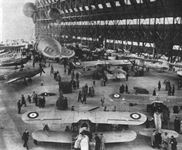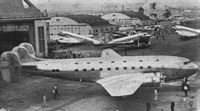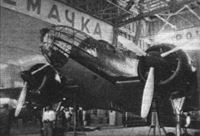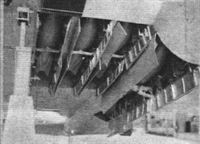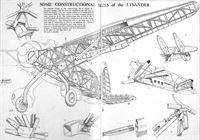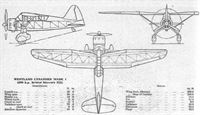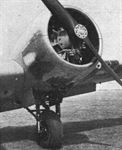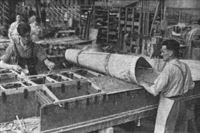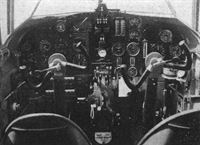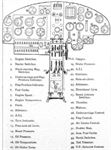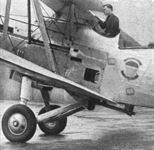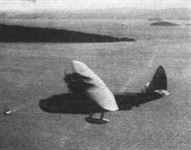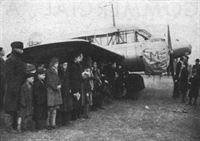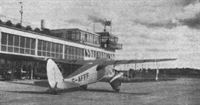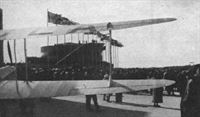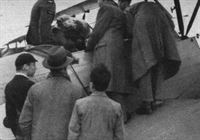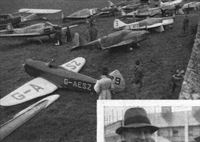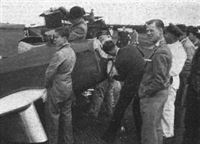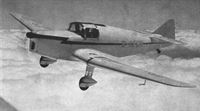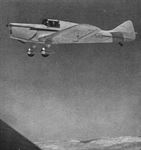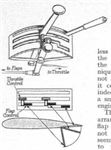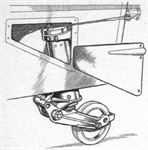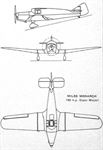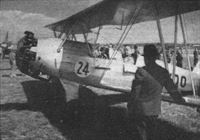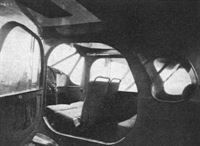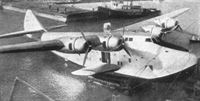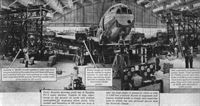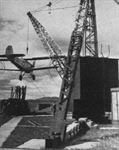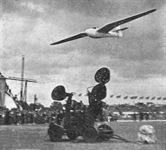Фотографии
-
Lighter-and-heavier-than-air Day in the big hangar at Cardington. In this non-stop variety picture are barrage balloons, a Blenheim and a Battle (left), a new Hind Trainer (foreground), Hector, Shark, Swordfish and Cloud (right), not to mention other less discernible aircraft and a goodly proportion of the population of Bedfordshire.
Самолёты на фотографии: Blackburn Shark / B-6 - Великобритания - 1933Bristol Blenheim - Великобритания - 1936Fairey Battle - Великобритания - 1936Fairey Swordfish - Великобритания - 1934Hawker Hector - Великобритания - 1936Hawker Hind - Великобритания - 1934Saunders-Roe Cloud / A.19 - Великобритания - 1930
-
Garden parties at Whitchurch always seem to produce a nice intermingling of people and aeroplanes, with a leavening of motor-car. A local visitor - with civil markings - will be recognised.
Самолёты на фотографии: Bristol Blenheim - Великобритания - 1936
-
A DIFFERENT D.C.3; The first of K.L.M.’s Douglas D.C.3 twenty-one seaters with G.100 Wright Cyclones and Curtiss fully-feathering variable-pitch airscrews. The engines are rated at 1,100 h.p. for take-off and use 90-octane fuel.
Самолёты на фотографии: Douglas DC-3 / C-47 Skytrain/С-53 Skytrooper / Dakota - США - 1935
-
Регистрационный номер: NX18100 D.C.4 EMERGES: After successfully passing some remarkable static tests, the Douglas D.C.4 appears in the open. The huge proportions of this latest tricycle transport can be gauged from the familiar Douglas types in the background.
Самолёты на фотографии: Douglas DC-3 / C-47 Skytrain/С-53 Skytrooper / Dakota - США - 1935Douglas DC-4E - США - 1938
-
Регистрационный номер: L4032 [3] PROBOSCIDAL MODS: The new nose of the Handley Page Hampden bomber (two Pegasus) as now in quantity production. Deliveries will start very shortly. Note the dihedral on the wings and the revised gun position.
Самолёты на фотографии: Handley Page Hampden / H.P.52 - Великобритания - 1936
-
Exalted interest in the H.P. Hampden. From left to right : Mr. J. Baum, Mayor of St. Albans; Mr. S. R. Worley, chairman of Handley Page, Ltd. ; Sir Kingsley Wood, Secretary of State for Air; Viscountess Hampden; Viscount Hampden; and Mr. F. Handley Page. The internal structure is revealed by the complete disappearance (photographically) of the moulded Perspex windows.
Самолёты на фотографии: Handley Page Hampden / H.P.52 - Великобритания - 1936
-
Регистрационный номер: L4032 [3] The Handley Page Hampden medium bomber (two Bristol Pegasus) posing for its portrait after last Friday's ceremony.
Самолёты на фотографии: Handley Page Hampden / H.P.52 - Великобритания - 1936
-
Регистрационный номер: L4032 [3] THE REVISED HAMPDEN: Liberal application of slots and flaps combines with clean design and Pegasus engines of the latest series to make the Handley Page Hampden bomber (seen here in its production form) one of the fastest machines of its calibre in the world.
Well defended and able to carry a heavy load at high speed, the Handley Page Hampden, in production for the R.A.A.F., is a brilliant example of the modern twin-engined bomberСамолёты на фотографии: Handley Page Hampden / H.P.52 - Великобритания - 1936
-
Регистрационный номер: K9787 High-speed visitor: The Supermarine Spitfire. A few moments after landing it was surrounded by a seething crowd of interested enthusiasts.
Самолёты на фотографии: Supermarine Spitfire - Великобритания - 1936
-
This exclusive picture was secured by Flight's chief photographer when a production Vickers-Supermarine Spitfire was undergoing acceptance trials in the hands of F/O J. K. Quill. This new fighter, which is powered with the 1,050 h.p. Rolls-Royce Merlin, may be said to have been developed from the design of the Supermarine racing seaplanes which won outright for Britain the Schneider Trophy. It will be noticed that ducted radiators are situated in an unusual position - beneath the wing.
Самолёты на фотографии: Supermarine Spitfire - Великобритания - 1936
-
Самолёты на фотографии: Supermarine Spitfire - Великобритания - 1936
-
Самолёты на фотографии: Supermarine Spitfire - Великобритания - 1936
-
Самолёты на фотографии: FIAT BR.20 Cicogna - Италия - 1936
-
The Fiat B.R.20, seen in side and front elevation on this page, has a top speed of over 260 m.p.h. This machine is in quantity production for the Regia Aeronautica
Самолёты на фотографии: FIAT BR.20 Cicogna - Италия - 1936
-
The Polish twin-engine PZL-37 bomber (which is shown fitted with Pegasus engines);
Самолёты на фотографии: PZL P.37 Los - Польша - 1936
-
The bomb cells on the Polish twin-engine PZL-37 bomber;
Самолёты на фотографии: PZL P.37 Los - Польша - 1936
-
Регистрационный номер: K6128 A Lysander in pre-camouflage colourings.
Самолёты на фотографии: Westland Lysander - Великобритания - 1936
-
ALL IS NOT WHEEL ... A close-up, with part of the fairing removed, of the Westland Lysander’s undercarriage. Revealed is the Dunlop-tyred Dowty internally sprung wheel; concealed is the machine gun, though its port can be seen, as can the Harley landing light.
Самолёты на фотографии: Westland Lysander - Великобритания - 1936
-
Самолёты на фотографии: Westland Lysander - Великобритания - 1936
-
Sir Kingsley, inspecting the Service types, chats with the pilot - in Army uniform - of a Westland Lysander army-co-operation machine.
Самолёты на фотографии: Westland Lysander - Великобритания - 1936
-
The view clearly shows the why and wherefore of camouflage.
Самолёты на фотографии: Westland Lysander - Великобритания - 1936
-
A refreshing change from the orthodox low-wing monoplane, the Westland Lysander is a fine example of design for a specific purpose - in <...>co-operation. Among its duties which will mainly be performed at low altitude, are general liaison work with bodies of troops on the move (equipment includes a message hook, and the machine can operate from very small fields), low bombing and machine-gunning, photography <...>ery co-operation, and transport of executive officers. The inset shows the frontal aspect, and the arrangement of the bombs on the detachable stubs. A future version - the Mark II - have the sleeve-valve Perseus engine.
Самолёты на фотографии: Westland Lysander - Великобритания - 1936
-
The inverted U-tube of the undercarriage (A) is carried on a triangular forging. The lift struts are attached by the fork seen just below this forging. The rear fuselage portion is of welded-steel-tube construction, while the front portion is mainly of square duralumin tubes, joined as at B. The undercarriage tube is free to flex in a vertical plane but prevented from moving laterally by the arrangement shown in C. The leading-edge ribs of the wing are of the same type of construction as those of the tailplane (D). Details of front and rear spar construction, and drag bracing are seen at E. The lift struts (F) are H-section extrusions with fairings. G shows drag members and their attachments at the point on rear spar where the lift strut is attached.
Самолёты на фотографии: Westland Lysander - Великобритания - 1936
-
Reynolds extrusions used in the Lysander. The smaller ones are used for window frames and similar purposes, while the central one is a main wing spar extrusion. Behind that are two standardised channels used extensively for making forked lugs. The extrusion on the right is used for the lift struts.
Самолёты на фотографии: Westland Lysander - Великобритания - 1936
-
Straight and sloping forked lugs are cut from special channel-section extrusions.
Самолёты на фотографии: Westland Lysander - Великобритания - 1936
-
Westland Lysander Mark I (890 h.p. Bristol Mercury XII)
Самолёты на фотографии: Westland Lysander - Великобритания - 1936
-
Регистрационный номер: D-AETA IN SERVICE: The first of D.L.H.’s new Focke-Wulf Condors puts in an appearance at Croydon after being brought over on the normal morning service from Berlin. Obviously the airport residents do not often have a chance of seeing something really new; they are still waiting for the first Ensign - though this should be putting in an appearance any day now.
Самолёты на фотографии: Focke-Wulf FW.200 Condor - Германия - 1937
-
The flaps of the Oxford are used only for the approach and landing. The air-heater muff can be seen in this view
Самолёты на фотографии: Airspeed Oxford / AS.10 - Великобритания - 1937
-
Motive power: One of the two Cheetah Xs (375 h.p. each for take-off) of the Airspeed Oxford. Later models will have D.H v.p. airscrews.
Самолёты на фотографии: Airspeed Oxford / AS.10 - Великобритания - 1937
-
A view showing the small triangular DV (Direct Vision) window in an Oxford, in the open position. The author was involved with, amongst other things, the testing of this window.
The cockpit roof of the Oxford is of exceptionally good design to permit unobstructed view in all essential directions. In this view the remaining sections of Perspex moulding are seen being put into place and sealed with Bostik compound.Самолёты на фотографии: Airspeed Oxford / AS.10 - Великобритания - 1937
-
In the works: Applying the plywood skin to a fuselage side in its jig.
Самолёты на фотографии: Airspeed Oxford / AS.10 - Великобритания - 1937
-
Mr. G. B. S. Errington, chief test pilot to Airspeed, Ltd.
Самолёты на фотографии: Airspeed Oxford / AS.10 - Великобритания - 1937
-
The controls and instrument panel of the Oxford. Below the standard R.A.F.-type blind-flying panel will be seen the bomb release switches. The throttle column carries, also, under-carriage, airscrew pitch and flap controls, together with rudder-bias adjustment. Brake controls will be seen on each control column.
Самолёты на фотографии: Airspeed Oxford / AS.10 - Великобритания - 1937
-
A key to the instruments, some of which are duplicated for the pupil.
Самолёты на фотографии: Airspeed Oxford / AS.10 - Великобритания - 1937
-
Регистрационный номер: K7554 The Hawker Henley bomber as modified for high-speed target towing. Armament Training Stations will shortly be issued with these machines. The engine is a Merlin.
Самолёты на фотографии: Hawker Henley - Великобритания - 1937
-
The Hawker Henley bomber as modified for high-speed target towing. Armament Training Stations will shortly be issued with these machines. The engine is a Merlin.
Самолёты на фотографии: Hawker Henley - Великобритания - 1937
-
The tied-together Gladiators of No. 87 (F.) Squadron.
Самолёты на фотографии: Gloster Gladiator - Великобритания - 1934
-
The new Macchi C.200 single-seater fighter;
Самолёты на фотографии: Macchi MC.200 Saetta - Италия - 1937
-
The stop-butts scene is also at Kenley; the machine that is firing is a Gloster Gauntlet.
Самолёты на фотографии: Gloster Gauntlet - Великобритания - 1929
-
The modification of a Hawker Hind for high-speed parachute dropping at Henlow. Speeds of about 320 m.p.h are attained before release of the dummy. A static line is fitted to ensure clearing the structure. This Hind gave a demonstration on Empire Air Day
Самолёты на фотографии: Hawker Hind - Великобритания - 1934
-
ATTACK: Two Douglas parasol observation monoplanes and a Northrop attack machine of the U.S. Army Air Corps go forward to clear the way for a flock of tanks during combined manoeuvres in Georgia.
Самолёты на фотографии: Douglas O-46 - США - 1934Northrop A-17 / 8A Nomad - США - 1934
-
THE WINGED SHADOW: The shadow of a Blackburn Shark floatplane (Siddeley Tiger VI) flits symbolically over the bows of H.M.S. Nelson. This picture was taken from another F.A.A. machine as the Nelson was steaming into Weymouth Bay with the rest of the Home Fleet in readiness for the King's visit to the Fleet last Monday.
Самолёты на фотографии: Blackburn Shark / B-6 - Великобритания - 1933
-
Though this page is normally confined to flying models, we feel that this non-flying scale model of a Blackburn Shark is of such exceptional merit that it deserves a place. It was built to a scale of 1/2 in. to 1 ft. by Mr. J. R. Managh, of Winnipeg, working from Flight drawings and photographs of the original.
Самолёты на фотографии: Blackburn Shark / B-6 - Великобритания - 1933
-
Самолёты на фотографии: Fairey Gordon / Seal - Великобритания - 1931
-
Регистрационный номер: L2160 [2] THE SHORT "SUNDERLAND": 4 "Bristol" Pegasus. The first four-engined monoplane flying boat for the R.A.F. An all-metal, high-wing type, for long-range patrol, reconnaissance and bombing duties. Developed from the "Empire" civil type, and fitted with gun turrets in the nose and stern. Dimensions: span 114 feet, length 85 feet, height 33 feet. No official performance figures are available, but a flight of 1250 miles in 8 hours has been recorded. Design and construction by Short Bros. Ltd.
Самолёты на фотографии: Short Sunderland / S.25 - Великобритания - 1937
-
Регистрационный номер: L2160 [2] AT THE M.A.E.E.: A Short Sunderland long-distance flying boat (four Pegasus) on test near the Marine Aircraft Experimental Establishment, Felixstowe.
Самолёты на фотографии: Short Sunderland / S.25 - Великобритания - 1937
-
Some aspects of the new Short Sunderland flying boat: the nose.
Самолёты на фотографии: Short Sunderland / S.25 - Великобритания - 1937
-
Регистрационный номер: L2161 Some aspects of the new Short Sunderland flying boat: tail gun turrets.
Самолёты на фотографии: Short Sunderland / S.25 - Великобритания - 1937
-
The Short Sunderland, which appeared at Felixstowe; it is seen on the "production line" at Rochester.
Самолёты на фотографии: Short Sunderland / S.25 - Великобритания - 1937
-
Early morning at the Oslo seaplane base. The machine on the right is about to start for Bergen while that in the background departed an hour or two after the photograph was taken on the preliminary run to Tromso.
Самолёты на фотографии: Junkers Ju.52/3mW (See) - Германия - 1933
-
One of the Junkers Ju.52 used by D.N.L. Its appearance as a floatplane is distinctly improved, the "boots" balancing the bulk of the machine rather more adequately than the normal wheel undercarriage.
Самолёты на фотографии: Junkers Ju.52/3mW (See) - Германия - 1933
-
At the Stavanger seaplane base, with one of the Ju.52s taxying in after its run from Bergen on the way to Oslo. Sola is the refuelling point on the service.
Самолёты на фотографии: Junkers Ju.52/3mW (See) - Германия - 1933
-
The Sikorsky S.43 in flight near Oslo; this machine was originally purchased for a projected service to America via Iceland.
Самолёты на фотографии: Sikorsky S-43 Baby Clipper/JRS/Y1OA-8 - США - 1936
-
Symbolic? A general reconnaissance Anson at Hendon provides shelter against an unwelcome precipitation from the skies.
Самолёты на фотографии: Avro Anson / Type 652 - Великобритания - 1935
-
See how they run! A dual-control Swordfish, equipped with cockpit head-rests for catapulting in comfort, causes a stir at Calshot.
Самолёты на фотографии: Fairey Swordfish - Великобритания - 1934
-
Регистрационный номер: G-AFFF Bromma’s terminal building which has already been found to be too small for requirements and is likely to be extended during the next year.
Самолёты на фотографии: De Havilland Dragon Rapide / Dominie / D.H.89 - Великобритания - 1934
-
The scene at the opening ceremony, with the first of Aero’s two Rapides in the foreground.
Самолёты на фотографии: De Havilland Dragon Rapide / Dominie / D.H.89 - Великобритания - 1934
-
HARROWS EN MASSE: An impressive scene at Feltwell, Norfolk.
Самолёты на фотографии: Handley Page Harrow / H.P.54 - Великобритания - 1936
-
Самолёты на фотографии: Douglas DC-1 / DC-2 / C-32 / C-39 - США - 1933
-
An Avro Tutor loaded with eager humanity at Kenley.
Самолёты на фотографии: Avro Tutor/Sea Tutor/Prefect / Type 621/646/626 - Великобритания - 1929
-
Регистрационный номер: G-AESZ Black Monday: Some of the racing machines (and three non-competitors) picketed out in the gale on Whit - Monday, when the Island races had to be cancelled.
Самолёты на фотографии: Chilton D.W.1 - Великобритания - 1937
-
QUICK CHANGE: Mr. A. R. Ward replaces the airscrew on the Chilton monoplane at the Speke control during the Isle of Man air race. Meanwhile, Mr. Green of Stanavo tops up the tanks with four gallons - after the Chilton's 160 miles at full throttle. The other personalities are no doubt helping or hindering
Самолёты на фотографии: Chilton D.W.1 - Великобритания - 1937
-
PROVEN: After a year of successful operation with two D.H. Dragonflies, P.L.U.N.A., Uraguay's first airline, took delivery of a D.H.86B, which has now been carrying full passenger loads for four months. The machine is seen here with some notabilities - Mr. Ballantyne, D.H. manager in South America; Sr. Alberto Marquez Vaeza; Sta. Fleurquin; Dr. Fleurquin, a director of P.L.U.N.A ; Noack, chief pilot; and Capt. Nudelmann, pilot.
Самолёты на фотографии: De Havilland Express Air Liner / D.H.86 - Великобритания - 1934
-
The new terminal building and hangar at Sola Airport, Stavanger, with the Allied Airways 86B on the tarmac
Самолёты на фотографии: De Havilland Express Air Liner / D.H.86 - Великобритания - 1934
-
FLYING CLASSROOM: Two D.H.86Bs have been specially equipped for instructing Cranwell cadets in aircraft radio operation (including D/F) and the working of the automatic pilot. There are two seats for instructors and six for pupils, each of whom has a receiver, while one also has a transmitter. In the casing on the left pupils can watch the R.A.E. special automatic pilot in action. The machines have full Service night-flying equipment.
Самолёты на фотографии: De Havilland Express Air Liner / D.H.86 - Великобритания - 1934
-
Регистрационный номер: G-AFCR [3] Самолёты на фотографии: Miles Monarch / M.17 - Великобритания - 1938
-
Регистрационный номер: G-AFCR [3] Plan form: Unmistakably Milesian is the Monarch viewed from this angle. For this and the other photographs the machine was posed by Mr Skinner, the chief test pilot while Capt Ayre flew the photographic platform - a Whitney Straight with a Series II Gipsy Major.
Самолёты на фотографии: Miles Monarch / M.17 - Великобритания - 1938
-
Регистрационный номер: G-AFCR [3] This is sunshine: The Monarch flying above the clouds near Reading.
Самолёты на фотографии: Miles Monarch / M.17 - Великобритания - 1938
-
Diagrammatic and perspective drawings which show the simple operation of the interconnection and gate arrangement of the throttle and flap controls.
Самолёты на фотографии: Miles Monarch / M.17 - Великобритания - 1938
-
The layout of the controls, of the third seat and of the luggage compartment are clearly shown in this cut-away sketch ol the interior of the Monarch. The flap control is shown in the 25-degree position, with the throttle half open
Самолёты на фотографии: Miles Monarch / M.17 - Великобритания - 1938
-
The new Mentor-type magnesium alloy tail wheel unit of the Monarch.
Самолёты на фотографии: Miles Monarch / M.17 - Великобритания - 1938
-
Mile Monarch (130 h.p. Gipsy Major)
Самолёты на фотографии: Miles Monarch / M.17 - Великобритания - 1938
-
Регистрационный номер: G-AEXF Percival Mew Gull
Самолёты на фотографии: Percival Mew Gull - Великобритания - 1934
-
Регистрационный номер: G-ADNO The De Havilland Technical School’s T.K.2 has a redesigned cabin enclosure, a reduced wing span and other improvements.
Самолёты на фотографии: De Havilland Technical School T.K.2 - Великобритания - 1935
-
ECONOMICAL EXPERIMENT: The scale flying model of the CAMS-Potez 161 flying boat for the North Atlantic service. The building of models of this sort permits early and economical research to be conducted. In this case the engines are 40 h.p. Trains, and the pilot is also the chief designer.
Самолёты на фотографии: Potez-CAMS Potez-CAMS 160 / 161 - Франция - 1938
-
Регистрационный номер: D-EVQO [2], D-ICIS The scene on and beyond the tarmac at Hatfield before the machines were taxied out to the starting line. The change in the weather conditions between start and finish is obvious.
Самолёты на фотографии: Focke-Wulf FW.44 Steiglitz - Германия - 1932Messerschmitt Bf.108 Taifun - Германия - 1934
-
Регистрационный номер: D-EVQO [2] Herr Gerbrecht, in the Focke-Wulf F.W.44, was second in the Manx Air Derby at 108.45 m.p.h.
Самолёты на фотографии: Focke-Wulf FW.44 Steiglitz - Германия - 1932
-
COMFORT FROM ITALY: Inside the four-seater cabin of the Breda 79 S. A special effort has been made to provide plenty of room and effective adjustibility for the seats. Since the majority of Continental pilots fly with parachutes, both the doors and the cabin top have been designed so that they can, in emergency, be simultaneously removed by the movement of a single control. The width of the doors, incidentally, is notable. The 79 S cruises at 150 m.p.h. on 200 h.p.
Самолёты на фотографии: Breda Ba.79 - Италия - 1936
-
As on other current Fiat types the inboard sections of the wing of the G.18-V are thickened.
Самолёты на фотографии: FIAT G.18 - Италия - 1935
-
Регистрационный номер: I-ENEA The somewhat unusual fuselage shape of the G.18-V is apparent here. Although the bottom and sides are flat, the top speed is about 250 m.p.h. with two eighteen-cylinder Fiat radials of 1,000 h.p. each.
Самолёты на фотографии: FIAT G.18 - Италия - 1935
-
The eighteen-seater cabin of the G.18-V used on the London-Venice route by Avio Linee.
Самолёты на фотографии: FIAT G.18 - Италия - 1935
-
Регистрационный номер: OO-AUC The first of Sabena's new Savoia-Marchetti S83 machines which are intended eventually for use on the company’s Congo service. With three Wright-Cyclone G.2 engines this machine has a top speed of 268 m.p.h.
Самолёты на фотографии: Savoia-Marchetti / SIAI SM.83 - Италия - 1937
-
FOR THE ATLANTIC: The first of the Boeing 314 flying boats for Pan American Airways takes the water at Seattle. The all-up weight is about 82,500 lb. (37 tons) and the engines are the new two-row Cyclones, each of which develops a maximum of 1,500 h.p. Remembering the present vogue for two, or even three rudders, the single one on this Boeing certainly seems to be on the small side. The all-up weight of the specially stressed Short boat is 52,000 lb.
Самолёты на фотографии: Boeing Boeing 314 Clipper - США - 1938
-
This annotated photograph, issued by the Douglas Company, gives a good idea of the general scheme of the tests.
Самолёты на фотографии: Douglas DC-4E - США - 1938
-
Showing details of the gear with which loads of 180,000 lb. were applied to the wings of the D.C.4.
Самолёты на фотографии: Douglas DC-4E - США - 1938
-
Регистрационный номер: NR1050 [2] Major Al Williams
Самолёты на фотографии: Grumman F3F - США - 1935
-
Регистрационный номер: NR1050 [2] Major Al Williams - and his mount. The Grumman Gulfhawk may not be the prettiest of aeroplanes, but it is nicely suited to its pilot’s aerobatic repertoire.
Самолёты на фотографии: Grumman F3F - США - 1935
-
A hypothetical military version of the Lockheed 14 with three guns and a heavy bomb load.
Самолёты на фотографии: Lockheed Super Electra 14 - США - 1937
-
Mr. Martin’s next? A projected four-engined boat with a hull that is “easy on the wind tunnel.”
Самолёты на фотографии: Martin Russian Clipper / Type 156 - США - 1937
-
Регистрационный номер: X2080 The new North American Trainers are likely to resemble this Wasp-engined model
Самолёты на фотографии: North American BT-9/NJ/NA-16, -19, -28 - США - 1935
-
A Hawker Osprey being loaded on to the catapult at Leuchars
Самолёты на фотографии: Hawker Osprey - Великобритания - 1930
-
The new Schwarz v.p. airscrew, seen on Seidemann’s Ago.
Самолёты на фотографии: AGO Ao.192 Kurier - Германия - 1935
-
One of the two German entrants in the race, Maj. Seidemann, who finished seventh, taxies in his Ago 192 while two other machines make their landing circuits.
Самолёты на фотографии: AGO Ao.192 Kurier - Германия - 1935
-
The third to arrive, Flt. Lt. H. R A. Edwards, emerges from his Avro Avian; very wet.
Самолёты на фотографии: Avro Avian / Type 594/616 - Великобритания - 1926
-
The second and first pilots home, Messrs. A. Henshaw and S. T. Lowe, face the weather with the former’s Gipsy Comper in the background.
Самолёты на фотографии: Comper Swift / CLA.7 - Великобритания - 1930
-
Регистрационный номер: G-ABWW The winner taxies in: Mr. Lowe about to notice the difference between horizontal and vertical rainfall.
Самолёты на фотографии: Comper Swift / CLA.7 - Великобритания - 1930
-
Регистрационный номер: G-AEGH The Parnall Heck
Самолёты на фотографии: Parnall Hendy Heck - Великобритания - 1934
-
Регистрационный номер: L6846 The Miles Nighthawk in which Capt. Balfour, Under-Secretary of State for Air, toured a number of stations.
Самолёты на фотографии: Miles Nighthawk M.7 / Mentor M.16 - Великобритания - 1935
-
Регистрационный номер: G-ADNL Miles Sparrowhawk
Самолёты на фотографии: Miles Sparrowhawk / M.5 - Великобритания - 1935
-
FOR INDOOR FLYING: The little Miles Hobby undergoing a fuel flow test before going to Farnborough, where it is to be used for research in the full-scale wind tunnel. The machine is small enough to be tested complete.
Самолёты на фотографии: Miles Hobby / M.13 - Великобритания - 1937
-
The sound detectors detect not a sound as Marcel Doret’s gull-winged sailplane soars overhead.
Самолёты на фотографии: DFS Habicht - Германия - 1936
Статьи
- Flight
- Flight Advertisements
